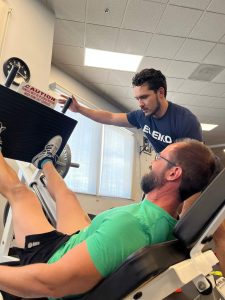Are you interested in hitting the gym to improve your health, quality of life, and build muscle? Or maybe you already train but feel lost when you walk in to the gym or lack purpose in your routine? Let’s explore the vital elements of a successful training routine, and their order of importance for long-term progress:
1. Consistency
The foundation of any effective program is consistency. Without it, even the best program is meaningless. Consistency allows for repeated exposure to training over time with increasing intensity, much like mastering any skill through practice. It’s the key to long-term progress, ensuring you challenge yourself consistently, and adapt accordingly.

2. Stimulus
The next priority is stimulus, which depends on your training plan’s goal. For novices to resistance training, mastering basic movements with proper form and technique is the primary focus. These fundamental human movements include squats, hinges, single-leg exercises, upper body presses, horizontal and vertical pulls, and core exercises. For beginners, simplicity is key, as any training done consistently will build muscle and strength.

If you’ve progressed beyond the novice stage and find your training is stalling, the type of stimulus you must emphasize depends on your goal. To gain strength, your program should reflect that in the exercises, rep ranges, and weights you use (3-6 reps on the compound lifts you want to get stronger at, and 6-10 reps on accessory lifts). If you’re pursuing muscle growth, focus on exercises that challenge the target muscles, with appropriate techniques and rep ranges (typically 6-30 reps, depending on the exercise or muscle group). Intermediate and advanced trainees interested in strength and muscle should consider specific phases where they prioritize strength or hypertrophy, which often yield better results over time (more on that at the end).
3. Effort
Effort is the third most important element in your training. Your workouts should be demanding enough to elicit changes in your body and abilities. However, effort comes after stimulus because the proper intensity can only be applied when you have the correct movement patterns ingrained. You can find many people training plenty hard in gyms worldwide, sometimes to the point of compromising form and risking injury. To ensure progress, you need to build a strong foundation first.

For beginners, effort mainly revolves around learning to challenge yourself but not at the expense of form or technique. The minimum thresholds for strength and hypertrophy should be challenging but not overdone, as beginners will generally progress no matter how hard they train.
If you are an intermediate/advanced trainee, and find you stall out consistently in your lifting progress, the following minimum effort should be applied (and exceeded) to make progress:
- For strength training, focus on putting 100% effort into each movement, producing maximal force with sub-maximal weights, typically between 70-85% of your one-rep max, in the 3-6 rep range. Your sets should challenge you without compromising your form, with 3-4 “Reps in Reserve.”
- For Hypertrophy/muscle building each set should leave you with no more than 3-4 “Reps in Reserve.” This means you can perform 3-4 more reps with good form beyond what you actually complete. Progress closer to failure (3, 2, 1, or 0 “Reps in Reserve”) does generally result in greater stimulus, although the returns diminish in magnitude.
4. Progressive Overload
Achieving consistent progress requires applying the principle of Progressive Overload. Over time, you should incrementally increase the challenges you face to provide more stimulus and achieve your desired result, whether strength, hypertrophy, or improved sport performance. A well-designed program integrates this principle by gradually increasing intensity, volume, and load on a weekly basis. This means that from the first to the last week of your program, the training demand, and resultant performance, should consistently increase and improve to yield progress.
To apply the principle of Progressive Overload effectively, start with a very achievable “week 1”, knowing that training demand will only increase from there.
For beginners, it’s optimal to start a bit “too easy,” leaving room for gradual increases in loads and reps each week. This approach is essential for building good technique, experiencing successively harder weeks, and ingraining long-term training habits.
Intermediate to advanced lifters should start their training within the range of loads and intensities that promote progress:
- For strength begin with an intensity of 70-80% of your one-rep max for 3-6 reps.
- For Hypertrophy, begin with an intensity of 3-4 Reps in Reserve, anywhere from 6-30 reps depending on the movement.

In either case, start with loads that are challenging while maintaining stable form and technique, and leave room for improvement on a weekly basis.
5. Periodization: Planning for progress and deloads
Periodization is a systematic approach to structuring training programs into distinct phases, each with specific training goals and intensities. This strategy is aimed at optimizing long-term performance and is crucial for longevity in strength, hypertrophy, and conditioning.
This strategy allows you to rotate between adaptation goals productively.
Training for hypertrophy, strength, or sport performance in set phases allows you more progressive overload in each than any one combined phase could do alone. While fundamental for athletes, this approach gives the average gym goer a productive amount of variety to stay interested in training and provides long-term challenges to stay in the game and make progress.

In the short term, periodization enables you to plan for progressively challenging weeks, followed by planned breaks to recover and make further gains. After every deload week, you can look forward to another 4, 5, or 6 weeks of training progress. Knowing the number of weeks for progression provides clarity and motivation to apply yourself to your training, knowing which weeks to temper performance, and which week you can empty the tank on (the last one).
However, after several weeks of advancing progressive overload, your progress may slow, or you might even experience setbacks due to accumulating fatigue, mental exhaustion, and physical wear and tear.
Long-term progress isn’t linear, and requires moderation and a lengthened time horizon to maintain motivation.
This is where the concept of a deload becomes invaluable.
A deload week in exercise science is a period of planned reduction in training intensity, volume, and frequency to promote recovery, prevent injury, and maintain mental freshness after weeks of intense training. To make progress, at time you’ve got to take a step back in your training now, in order to take more big steps forward in your training in the future.
An effectively executed deload week reduces fatigue, allows recovery from intense training, and mentally prepares you to push hard again, enhancing future progress.

Reframe unplanned training breaks: Unwelcome defeat, or a productive part of the process?
For beginners or “lifestyle” lifters, deloads may not be explicitly planned. They may occur taking breaks due to stalling and burnout, a hectic work week, or holidays and vacations when the gym isn’t the top priority. For beginners, consistent progress before and after such breaks can turn what may seem like a setback into a win. Reframing these breaks as necessary and beneficial to overall progress can help beginners embrace them without additional psychological stress.
Plan deload weeks for structured training and long-term success.
For intermediate lifters or those seeking next level strength and muscle progress, planned deload weeks are essential for long-term performance. Deloading reduces the risk of injuries, provides relief from wear and tear, and allows for recovery, paving the way for gains in subsequent weeks of training.
In the short or long term, periodizing your training goals and programs, and planning for deloads to recover is a consistent way to approach many weeks of challenging training. Planning distinct phases of training provides clear short term goals and progress, while keeping you motivated and focused on the longevity of your training career.
In Conclusion…
Whether you’re new to lifting or and intermediate to advanced lifter, adhering to this hierarchy of training principles is essential for achieving consistent long-term progress. Only through consistent training with quality stimulus, performed with enough effort progressively increased over time will you consistently make progress in building strength and muscle. By repeating this process through periodization and planned deloads, you can achieve consistent, repeatable, and lifelong progress at any goal you set.
Ready for consistent progress and long-term success?
Explore the “Foundational Strength and Muscle 2-3x/wk” program, an excellent routine for beginner to intermediate lifters who need clear direction in their training. Focusing on applying these fundamental training concepts with no-nonsense exercise selection and steady progression, this program offers all the instruction and tutorials needed to start and maintain progress.
Purchase this program now for only $39 at:
https://ckstrength.com/products/training-programs
Find direction and progress with Online Coaching:
For personalized programming and custom nutrition coaching tailored to your strength, physique, or athletic goals, contact Christian directly via our Contact page.
Training in Tucson, AZ?
Find your new training home at Tucson’s premier training facility, Tucson Strength. With open gym memberships, group training, and one-on-one training and recovery options to fits your goals, visit the Tucson Strength Services page.
Email Christian at christian@tucsonstrength.com to schedule a consultation for in-person coaching and membership.
Prioritize your health.
Revolutionize your well-being with a personally tailored approach to longevity, disease prevention, and concierge medicine by visiting the Men’s Clinic for Wellness and Vitality.
